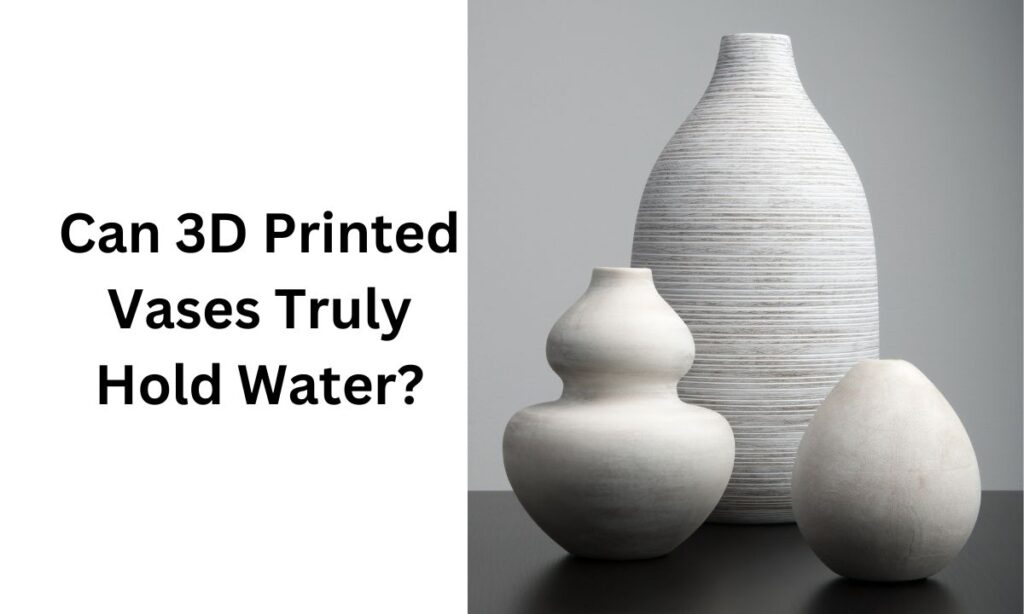
When decorating your home with a 3D printed vase, you might wonder: Can 3D printed vases truly hold water? The answer is yes—but only with the right choices in material, design, and a few finishing touches. With careful planning, you can create a vase that’s both beautiful and watertight. For a broader look at creating home accessories, check out our step-by-step guide to 3D print your own home accessories.
Affiliate Disclosure
We participate in Amazon affiliate programs, earning fees from qualifying purchases via links at no extra cost to you. It’s how we keep this blog rolling and my 3D printers buzzing with fresh filament for reviews like this one!
Related: 3D Printed Lighting: Illuminating Spaces with Unique Designs
Understanding Waterproof vs. Watertight: Why It Matters
To answer the question “Can 3D printed vases truly hold water?”, it’s essential to differentiate between waterproof and watertight. 3D printed objects, including vases, are constructed by layering plastic, which can create tiny gaps.
- Waterproof refers to a material’s natural ability to resist water without degrading over time.
- Watertight means the design is sealed effectively, preventing any water from leaking through even the smallest spaces.
For a functional 3D printed vase, you’ll need both waterproof materials and a design that enhances watertightness. For more on material choices, see our PLA vs. ABS vs. PETG comparison.
Choosing the Right Thermoplastic for Waterproofing
The material you choose has a significant impact on your vase’s ability to hold water. PLA and PETG are popular options, but they have different levels of water resistance.
- PLA: This is a beginner-friendly, biodegradable material but not ideal for long-term water exposure, as it can become brittle over time.
- PETG: PETG offers high durability and better water resistance than PLA. It’s an excellent choice for vases that need to hold water. However, it has limited UV resistance, so avoid placing it in direct sunlight to prevent degradation. For vases that will hold water reliably, PETG with UV-protective coatings is often your best bet.
Pro Tip: When choosing filament, consider brands known for high-quality PETG that’s designed for maximum durability and waterproofing. Check out our top 5 filaments for 3D printing for recommendations.
Setting Up for Success: Ideal Print Settings
Achieving a watertight vase also depends on your print settings. Here are some settings that can make a big difference:
- Wall Density: For better water resistance, aim for a wall thickness of 2-3 millimeters. This density reduces gaps and enhances your vase’s strength.
- Larger Nozzle Size: Using a larger nozzle (0.6 mm or 0.8 mm) allows for broader layers, which gives layers a larger bonding surface. This can make the vase walls denser and less prone to leaks.
- Pros: Strong, sturdy walls and time-saving in ‘vase mode.’
- Cons: Less detail and occasional minor inconsistencies if the printer isn’t perfectly tuned.
- Multiple Wall Layers: Adding 4-6 wall layers can improve density without sacrificing layer height. This technique works well for intricate designs that need more than just thickness to prevent leaks.
- Pros: Higher density without nozzle changes; suitable for complex shapes.
- Cons: Increases print time as more layers are added.
Experiment with these settings to see what works best for your design! For more on optimizing prints, read our 3D printing tips for beginners.
Related: How to Create Amazing Vases with a 3D Printer?
Designing a Waterproof Vase
Design simplicity is key when creating a watertight vase. Complex textures or shapes with a “staircase” effect may look stunning but are more prone to leaks. Subtly curved or smooth shapes are easier to waterproof and tend to hold water better. For design inspiration, explore our guide on designing your own 3D printed decor.
Tip: Don’t be afraid to test different designs! If your first attempt leaks, slight design tweaks or extra walls can make all the difference.
Post-Processing Techniques for Watertight Results
Sometimes, even with the perfect material and design, your vase might still need a bit of extra help to be watertight. Here are some popular techniques to add that final protective layer:
- Epoxy Resin Coating: A thin layer of epoxy resin inside the vase creates a durable, water-resistant seal. Pour a small amount inside the vase and rotate it to coat the walls evenly.
- Acrylic Lacquer: Similar to epoxy, acrylic lacquer is another option for sealing the interior, making your vase water-holding without affecting the exterior look.
Safety Tip: When working with resins or lacquers, ensure proper ventilation and use gloves to avoid skin contact. Apply coatings with precision, especially if you want only the inside to be sealed. For more post-processing tools, check out our top 10 post-processing tools for 3D printed decor.
Caring for Your 3D Printed Vase
To keep your 3D-printed vase in top condition:
- Avoid prolonged exposure to sunlight, especially if you used PETG, as UV rays can degrade its quality over time.
- Clean with a damp cloth to maintain the integrity of any coatings or post-process treatments you’ve applied.
With these care tips, your 3D-printed vase should last much longer and retain its water-holding capabilities. For detailed waterproofing steps, see our step-by-step guide to waterproofing 3D printed vases.
Conclusion: Creating a Functional and Beautiful 3D Printed Vase
So, can 3D printed vases truly hold water? Yes! By carefully choosing water-resistant materials like PETG, optimizing your print settings, and finishing with a waterproof coating, you can create a vase that is both functional and beautiful. It not only serves a practical purpose but also showcases the innovative world of 3D printing.
Looking to create more? Check out our guides on 3D printed plant pots for small apartments or dive deeper into sustainable 3D printed decor. Happy printing!
Frequently Asked Questions (FAQs)
Can all 3D printed vases hold water?
Not all 3D printed vases can hold water. The ability of a vase to hold water depends on the material used, the print settings (like wall density), and the design of the vase. Using water-resistant materials like PETG and ensuring a watertight design can significantly improve a vase’s ability to hold water.
What materials are best for creating waterproof 3D printed vases?
PETG is often recommended for creating waterproof vases due to its high durability and water resistance. While PLA is easier to work with, it is less water-resistant and can become brittle over time. Other materials like ABS or nylon may also be used, but they require specific printing techniques.
How thick should the walls of a 3D printed vase be to hold water?
A wall thickness of 2-3 millimeters is generally recommended for 3D printed vases that need to hold water. Thicker walls help reduce the likelihood of leaks and improve overall strength.
Are there any post-processing techniques to make a 3D printed vase waterproof?
Yes! Coating the inside of the vase with materials like epoxy resin or acrylic lacquer can create a watertight seal. These coatings help fill in any small gaps between layers, ensuring that water doesn’t escape.
How should I care for my 3D printed vase to ensure its longevity?
To care for your 3D printed vase, clean it with a damp cloth to avoid damaging the surface. Avoid prolonged exposure to UV rays, especially if the vase is made from PETG, as this can lead to material degradation. Proper care will help maintain both its aesthetic appeal and functionality over time.













